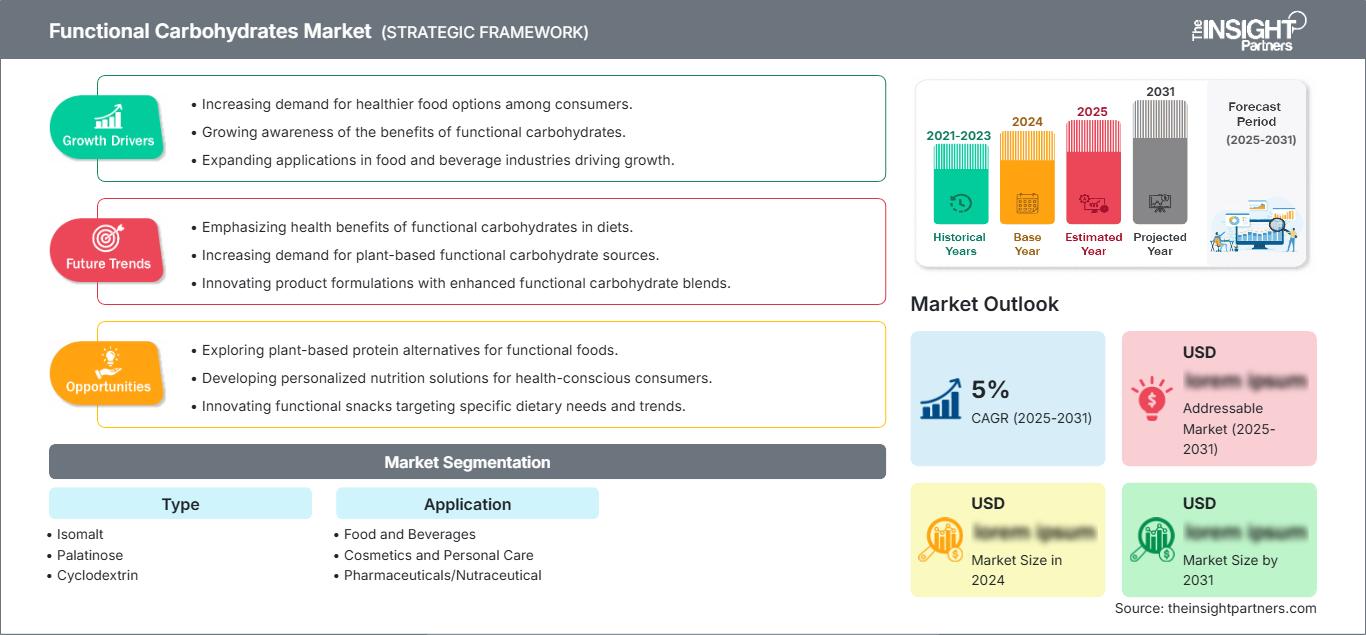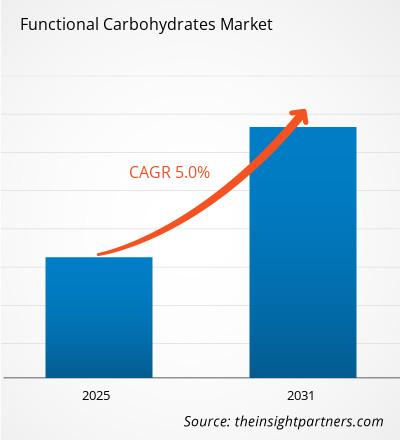Der Markt für funktionelle Kohlenhydrate wird zwischen 2023 und 2031 voraussichtlich eine durchschnittliche jährliche Wachstumsrate (CAGR) von 5 % verzeichnen. Die steigende Nachfrage nach gesünderen Lebensmitteln wird voraussichtlich ein wichtiger Markttrend bleiben.
Marktanalyse für funktionelle Kohlenhydrate
- Der globale Markt für funktionelle Kohlenhydrate verzeichnet aufgrund der steigenden Nachfrage nach gesunden Lebensmitteln und Getränken, der zunehmenden Verbreitung von Fettleibigkeit, Diabetes und Herz-Kreislauf-Erkrankungen sowie des zunehmenden Bewusstseins für funktionelle Kohlenhydrate ein starkes Wachstum.
- Gleichzeitig entwickeln die Marktteilnehmer ständig neue Produkte, um den Bedürfnissen der Verbraucher gerecht zu werden. Dazu gehört die Entwicklung neuer funktioneller Kohlenhydratzutaten mit potenziellem gesundheitlichen Nutzen sowie verbessertem Geschmack und verbesserter Funktionalität.
- Nachhaltigkeit ist ebenfalls ein neuer Trend auf dem Markt für funktionelle Kohlenhydrate. Hersteller suchen nach Quellen für Zutaten, die verantwortungsvoll und nachhaltig beschafft, mit minimalem Abfall produziert und mit einem geringeren ökologischen Fußabdruck hergestellt werden.
Marktübersicht für funktionelle Kohlenhydrate
- Funktionale Kohlenhydrate können in verschiedenen industriellen Anwendungen eingesetzt werden. Sie werden beispielsweise in Lebensmitteln und Getränken verwendet, darunter in Backwaren, Süßwaren, Milchprodukten, Getränken und Snacks. In der Tierfutterindustrie werden funktionelle Kohlenhydrate Futtermitteln zugesetzt, um die Gesundheit und Leistung der Tiere zu verbessern.
- Die Verbrauchertrends, die das Wachstum des Marktes für funktionelle Kohlenhydrate maßgeblich vorantreiben, sind die Nachfrage nach natürlichen und biologischen Zutaten und Clean-Label-Produkten sowie der Wunsch nach personalisierten Ernährungslösungen. Verbraucher suchen nach funktionellen Kohlenhydratzutaten, die bestimmte gesundheitliche Vorteile bieten, beispielsweise für die Darmgesundheit, die Unterstützung des Immunsystems und eine nachhaltige Energiefreisetzung.
- Der Markt für funktionelle Kohlenhydrate ist reguliert, um Sicherheit und korrekte Kennzeichnung zu gewährleisten. Die Food and Drug Administration (FDA) und die Europäische Behörde für Lebensmittelsicherheit (EFSA) legen Regeln und Vorschriften für die Verwendung funktioneller Kohlenhydrate in Lebens- und Futtermitteln fest.
Passen Sie diesen Bericht Ihren Anforderungen an
Sie erhalten kostenlos Anpassungen an jedem Bericht, einschließlich Teilen dieses Berichts oder einer Analyse auf Länderebene, eines Excel-Datenpakets sowie tolle Angebote und Rabatte für Start-ups und Universitäten.
Markt für funktionelle Kohlenhydrate: Strategische Einblicke

- Holen Sie sich die wichtigsten Markttrends aus diesem Bericht.Dieses KOSTENLOSE Beispiel umfasst Datenanalysen, die von Markttrends bis hin zu Schätzungen und Prognosen reichen.
Markttreiber und Chancen für funktionelle Kohlenhydrate Steigende Nachfrage nach Probiotika
Sie erhalten kostenlos Anpassungen an jedem Bericht, einschließlich Teilen dieses Berichts oder einer Analyse auf Länderebene, eines Excel-Datenpakets sowie tolle Angebote und Rabatte für Start-ups und Universitäten.
Markt für funktionelle Kohlenhydrate: Strategische Einblicke

- Holen Sie sich die wichtigsten Markttrends aus diesem Bericht.Dieses KOSTENLOSE Beispiel umfasst Datenanalysen, die von Markttrends bis hin zu Schätzungen und Prognosen reichen.
- Die gesundheitlichen Vorteile von Probiotika zur Unterstützung der Darmgesundheit und des allgemeinen Wohlbefindens werden bei Verbrauchern immer bekannter, ebenso wie die Marktchancen für personalisierte Lösungen. Dies dürfte die Nachfrage nach Präbiotika in vielen verschiedenen Formen, insbesondere funktionellen Kohlenhydraten, ankurbeln.
- Die Darmgesundheit ist schnell zu einem beliebten Gesprächsthema geworden. Verbraucher suchen nach Möglichkeiten, ihre Verdauung gesund zu halten, und Probiotika, auch solche auf Basis funktioneller Kohlenhydrate, haben sich als natürliche Lösung herausgestellt.
- Verbraucher suchen nach natürlichen Alternativen zu synthetischen Inhaltsstoffen, und pharmazeutische Lösungen werden sich zunehmend Probiotika als sichere und wirksame Alternative zur Verbesserung der Darmgesundheit und Heilung von Verdauungsproblemen zuwenden.
Wachsender Tierfuttersektor
- Mit der wachsenden Weltbevölkerung steigt auch die Nachfrage nach tierischen Produkten – Es wird erwartet, dass Fleisch, Milch und Eier einen größeren Viehbestand erfordern, der wiederum Tierfutter benötigt.
- Funktionale Kohlenhydrate können als Futterzusätze zur Verbesserung der Gesundheit des Immunsystems und der Darmfunktion bei Nutztieren und Aquakulturtieren eingesetzt werden.
- Tierzüchter zeigen ein zunehmendes Interesse an der Gesundheit und Leistung ihrer Tiere, um die Produktionseffizienz zu verbessern.
- Funktionale Kohlenhydrate als Futterzusätze haben sich als vorteilhaft für die Tiergesundheit erwiesen, z. B. durch eine verbesserte Darmgesundheit, eine verbesserte Nährstoffaufnahme und eine bessere Immunfunktion, was zu verbesserten Leistungsergebnissen wie verbesserten Wachstumsraten, verbesserter Futtereffizienz und psychischer Gesundheit führen kann.
Segmentierungsanalyse des Marktberichts über funktionelle Kohlenhydrate
Schlüsselsegmente, die zur Ableitung der Marktanalyse für funktionelle Kohlenhydrate beigetragen haben, sind Bereitstellungsart und Unternehmensgröße.
- Basierend auf dem Typ ist der Markt für funktionelle Kohlenhydrate in Isomalt, Palatinose, Cyclodextrin, Curdlan und andere unterteilt.
- Auf der Grundlage der Anwendung Der Markt ist in die Bereiche Lebensmittel und Getränke, Kosmetik und Körperpflege, Pharmazeutika/Nutraceutika und Sonstiges unterteilt.
Marktanteilsanalyse für funktionelle Kohlenhydrate nach Regionen
- Der Bericht zum Markt für funktionelle Kohlenhydrate enthält eine detaillierte Analyse der fünf wichtigsten geografischen Regionen, einschließlich der aktuellen und historischen Marktgröße sowie Prognosen für 2021 bis 2031 für Nordamerika, Europa, den asiatisch-pazifischen Raum (APAC), den Nahen Osten und Afrika (MEA) sowie Süd- und Mittelamerika.
- Jede Region ist weiter in entsprechende Länder unterteilt. Dieser Bericht bietet Analysen und Prognosen für mehr als 18 Länder und deckt die Marktdynamik für funktionelle Kohlenhydrate ab, wie z. B. Treiber, Trends und Chancen, die die Märkte auf regionaler Ebene beeinflussen.
- Darüber hinaus umfasst der Bericht eine PEST-Analyse, die die Untersuchung der wichtigsten Faktoren umfasst, die den Markt für funktionelle Kohlenhydrate in diesen Regionen beeinflussen.
Markt für funktionelle Kohlenhydrate
Die Analysten von The Insight Partners haben die regionalen Trends und Faktoren, die den Markt für funktionelle Kohlenhydrate im Prognosezeitraum beeinflussen, ausführlich erläutert. In diesem Abschnitt werden auch die Marktsegmente und die geografische Lage in Nordamerika, Europa, dem asiatisch-pazifischen Raum, dem Nahen Osten und Afrika sowie Süd- und Mittelamerika erörtert.Umfang des Marktberichts über funktionelle Kohlenhydrate
| Berichtsattribut | Einzelheiten |
|---|---|
| Marktgröße in 2024 | US$ XX million |
| Marktgröße nach 2031 | US$ XX Million |
| Globale CAGR (2025 - 2031) | 5% |
| Historische Daten | 2021-2023 |
| Prognosezeitraum | 2025-2031 |
| Abgedeckte Segmente |
By Typ
|
| Abgedeckte Regionen und Länder | Nordamerika
|
| Marktführer und wichtige Unternehmensprofile |
|
Dichte der Marktteilnehmer für funktionelle Kohlenhydrate: Verständnis ihrer Auswirkungen auf die Geschäftsdynamik
Der Markt für funktionelle Kohlenhydrate wächst rasant. Die steigende Nachfrage der Endverbraucher ist auf Faktoren wie veränderte Verbraucherpräferenzen, technologische Fortschritte und ein stärkeres Bewusstsein für die Produktvorteile zurückzuführen. Mit der steigenden Nachfrage erweitern Unternehmen ihr Angebot, entwickeln Innovationen, um den Bedürfnissen der Verbraucher gerecht zu werden, und nutzen neue Trends, was das Marktwachstum weiter ankurbelt.

- Holen Sie sich die Markt für funktionelle Kohlenhydrate Übersicht der wichtigsten Akteure
Der Markt für funktionelle Kohlenhydrate wird durch die Erhebung qualitativer und quantitativer Daten aus Primär- und Sekundärforschung bewertet, die wichtige Unternehmenspublikationen, Verbandsdaten und Datenbanken umfasst. Einige der Entwicklungen auf dem Markt für funktionelle Kohlenhydrate sind nachfolgend aufgeführt:
- Die Beneo GmbH führt mit ihrem Produkt Palatinose die nächste Stufe der Kohlenhydratfunktionalität ein. Die funktionellen Kohlenhydrate der Beneo GmbH wurden entwickelt, um Verbrauchern bei der Gewichtskontrolle und der täglichen Leistungsfähigkeit zu helfen. Verbraucher suchen daher nach funktionellen Kohlenhydraten, die ihnen bei der Kontrolle ihrer Ernährung helfen können, sei es aus Gewichts- oder Leistungsgründen. (Quelle: Pressemitteilung, Oktober 2017)
Bericht zum Markt für funktionelle Kohlenhydrate: Umfang und Ergebnisse
Der „Markt für funktionelle Kohlenhydrate: Größe und Prognose (2021–2031)“ Der Bericht bietet eine detaillierte Analyse des Marktes und deckt die folgenden Bereiche ab:
- Marktgröße und Prognose für funktionelle Kohlenhydrate auf globaler, regionaler und Länderebene für alle abgedeckten wichtigen Marktsegmente
- Markttrends und Marktdynamiken für funktionelle Kohlenhydrate wie Treiber, Einschränkungen und wichtige Chancen
- Detaillierte PEST/Porters Five Forces- und SWOT-Analyse
- Marktanalyse für funktionelle Kohlenhydrate mit wichtigen Markttrends, globalen und regionalen Rahmenbedingungen, wichtigen Akteuren, Vorschriften und aktuellen Marktentwicklungen
- Branchenlandschaft und Wettbewerbsanalyse mit Marktkonzentration, Heatmap-Analyse, prominenten Akteuren und aktuellen Entwicklungen für den Markt für funktionelle Kohlenhydrate
- Detaillierte Unternehmensprofile
- Historische Analyse (2 Jahre), Basisjahr, Prognose (7 Jahre) mit CAGR
- PEST- und SWOT-Analyse
- Marktgröße Wert/Volumen – Global, Regional, Land
- Branchen- und Wettbewerbslandschaft
- Excel-Datensatz
Aktuelle Berichte
Erfahrungsberichte
Grund zum Kauf
- Fundierte Entscheidungsfindung
- Marktdynamik verstehen
- Wettbewerbsanalyse
- Kundeneinblicke
- Marktprognosen
- Risikominimierung
- Strategische Planung
- Investitionsbegründung
- Identifizierung neuer Märkte
- Verbesserung von Marketingstrategien
- Steigerung der Betriebseffizienz
- Anpassung an regulatorische Trends




















 Kostenlose Probe anfordern für - Markt für funktionelle Kohlenhydrate
Kostenlose Probe anfordern für - Markt für funktionelle Kohlenhydrate